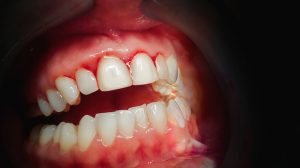Receding Gums: How to Treat a Common Condition
Receding gums aren’t just a source of pain and potentially unsightly, they also could be an indication that your teeth are in jeopardy.
Receding gums are just what you think they are: Gumlines that are pulling back and showing more of your teeth. That’s a worry because the gum’s job is to protect the roots of your teeth, and if you’re losing your gumline, your teeth may be in jeopardy. A healthy gum is pink, moist, and adheres tightly to your teeth, so it stops bacteria and debris from gaining access to the roots. It holds your teeth in place and prevents them from shifting.
Clearly, receding gums that expose an increasing amount of tooth are cause for concern. Once receding gums pass the “cosmetic” stage, where they may be unsightly, they can progress into gum disease, a.k.a. periodontal disease. Without a healthy gum to protect the tooth, you’re at risk of losing teeth.
You may notice some early warning signs of receding gums, like swollen gums, bleeding when brushing, or chronic bad breath. At later stages, you may experience pain and sensitivity. If you have any of these symptoms, hightail it to your dentist.
If you’re concerned about receding gums, you’re not alone. It’s one of the most common complaints from dental patients over 40. However, receding gums didn’t start overnight.

Bleeding gums and sensitivity at the gumline are signs that you should take steps to slow the progression.
When Do Receding Gums Start?
Most of us begin to experience receding gums in our teens and 20s—we just don’t know it! “Research published in the Journal of Dental Research states that almost half of 30-year-olds and almost three-quarters (70 percent) of 65-year-olds have reached the periodontitis stage,” according to The Happy Tooth dentistry in North Carolina. Periodontitis is the stage of dental disease that begins to permanently damage your gums and loosen teeth.
WHAT IS A “GUMMY SMILE”?
Instead of receding gums, some people battle having a “gummy smile,” where they believe there’s too much gum showing and not enough tooth. That’s a judgment call, though, not a health risk.
“There have been studies done to determine what people consider excessive gingival display,” according to a post by Moon Orthodontics in Overland Park, Kan. “In most cases, subjects rated smiles as attractive when 2 millimeters or less of gum tissue was exposed. At around 3 millimeters or more, the smile was thought to be gummy. Interestingly, the condition is more common in women than men. Some experts predict that about 14 percent of women and 7 percent of men have excessive gingival display.”
Causes of Receding Gums
Poor oral hygiene is the main cause of receding gums, but you may be surprised to learn that you can overdo it in the cleanliness department. Brushing or flossing too hard is a common cause of receding gums. Always use a toothbrush labeled as “soft.” Save the “hard” and “medium” brushes for cleaning around the house—not your teeth.
Additional causes of receding gums include:
- Bacteria below the gumline
- Diabetes
- Dry mouth
- Genetics
- Hormonal changes in women
- Human immunodeficiency virus (HIV)
- Injury to the teeth or gums
- Medications that cause dry mouth
- Plaque buildup
- Smoking
- Teeth grinding
- Teeth that are not aligned properly (Thank your parents for those braces, if you had to have them.)
- Tongue piercings
Treatments for Receding Gums
If you’re on top of things and notice receding gums, you may be able to halt or slow the process just by flossing regularly, brushing more gently, and paying attention to other good oral hygiene practices, like twice-a-year dental cleanings. Buy a high-quality toothbrush and, according to AskTheDentist.com, replace it every four weeks. Worn or cheap bristles can damage your gums.
Choose a gentle toothpaste, such as one for sensitive teeth. Avoid harsh, gritty toothpastes.
“Some toothpastes, especially those designated ‘tartar control,’ are too abrasive,” according to Shape.com. “Anything that feels gritty can erode enamel and cause receding gums. Fluoride is the only ingredient you need. Dentist-recommended toothpastes include: Mentadent ($3.29), Tom’s of Maine Natural Toothpaste ($4) and Sensodyne Fresh Mint ($4.39) for sensitive teeth.”
REPERCUSSIONS FROM PERIODONTAL DISEASE
Research has proven that people with periodontal disease are at a higher risk of developing cardiovascular disease and respiratory infections such as COPD (chronic obstructive pulmonary disease). The Centers for Disease Control and Prevention (CDC) reports that 47.2 percent of adults aged 30 years and older have some form of periodontal disease. That increases to 70.1 percent at ages 65 and older. “This condition is more common in men than women (56.4 vs 38.4 percent), those living below the federal poverty level (65.4 percent), those with less than a high school education (66.9 precent), and current smokers (64.2 percent),” says the CDC.
Your dentist can help advise you if you need more aggressive treatments, which may involve seeing a periodontist (gum specialist). Options include:
- Composite restoration involving tooth-colored composite resins or porcelain that either cover the exposed root and close gaps or, if pink, can be applied to the gums to do the same thing.
- Deep cleaning (tooth/root scaling), which removes the plaque that has built up on teeth below the gumline.
- Desensitizing agents that treat nerve symptoms.
- Orthodontic treatments to help reposition your teeth.
- Removable gum veneers that replace missing gum tissue.
Some people opt for a skin graft to correct receding gums. Tissue from the roof of your mouth or another area of your gum is removed and sutured to the receding gum. The periodontist may also remove a flap of the nearby gum. These procedures are usually done in the office.
Complications such as infection are rare but can occur. If the graft tissue doesn’t properly adapt to the graft site, you may need a repeat of the procedure. And if you’re not happy with the appearance of the graft, talk with your periodontist about a reshaping of gum tissue—a procedure called gingivoplasty.
Prevention of Receding Gums
It’s important to realize that there’s no set standard for what is too high a gumline or even what’s receding—at least in terms of how high your gum should appear on your tooth. Your ability to notice your receding gums at the earliest stage requires a familiarity of your gumline. Periodically look in that bathroom mirror and study your gumline and teeth, so you can gauge any loss.
Even more important: regular checkups. Your dentist can measure the distance between the bottom of each tooth and the gumline, tracking any movement over time.
In addition, if you look at the causes of receding gums, it’s obvious that flossing and brushing regularly with a soft brush are the most important ways to stop or slow receding gums. And if you’re a smoker, you can help yourself by quitting. A healthy lifestyle, regular medical care, and a nutritious diet are important not only to your overall health, but to your gum health. Finally, if you know or suspect your grind your teeth at night, discuss a mouth guard with your dentist.
SOURCES & RESOURCES
For related reading, please visit these posts:


 Vestibular Migraine Diet
Vestibular Migraine Diet  Bone Spurs on the Spine
Bone Spurs on the Spine  Knee Injections for Osteoarthritis Pain Relief
Knee Injections for Osteoarthritis Pain Relief 
Receding gums don't happen overnight; they may begin in our 30s or even younger.
© Robert Kneschke - Dreamstime.com